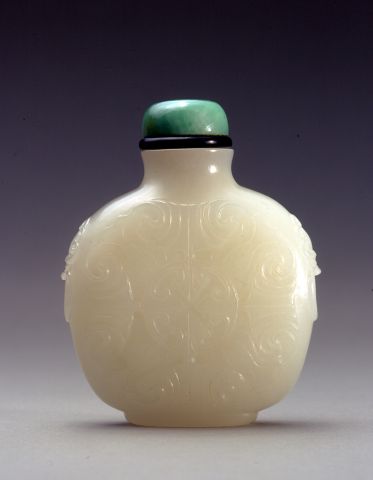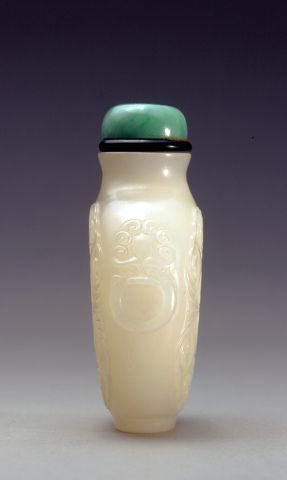

Bottle ID: 151
CARVED WITH LINGZHI FUNGUS HEADS
Date: 1750-1800
Height: 59 mm
Nephrite, very well hollowed, of even white tone, of flattened rounded form with shoulders sloping to an everted lip, carved in low relief on both sides with a central circular vignette of four lingzhi fungus heads with crossed stalks, surrounded by a further circular panel of four ornate scrolling lingzhi fungus heads; the sides carved with mock mask and ring handles and with a neatly carved oval footrim.
Imperial, attributed to the Palace Workshops, Beijing.
Similar Examples:
Moss, Hugh, Victor Graham and Ka Bo Tsang. A Treasury of Chinese Snuff Bottles - The Mary and George Bloch Collection, 1995, Vol. 1, pp. 234-237, no. 96.
Holden, Rachelle R. Rivers and Mountains Far From the World - The Rachelle R. Holden Collection, 1994, pp. 256-257, no. 112.
Hidden Treasures of the Dragon - Chinese Snuff Bottles from the Collections of Humphrey K. F. Hui, Margaret Polak and Christopher C. H. Sin, 1992, pp. 136-137, no. 273.
Provenance:
Clare Lawrence Ltd.
Joseph Baruch Silver
Belle Schoen
Mr. and Mrs. Martin Schoen
Exhibited:
Honolulu Academy of Arts, Honolulu, Hawaii, November 23, 1989 - January 7, 1990
Published:
Arts of Asia, January-February, 1982, p. 89
Until 1760 jade supplies were relatively scarce at the Palace, but from then on a total of two thousand kilograms of raw jade was given to the Qing court twice a year from the Xinjiang region, which had rich deposits of jade of superb quality. Presumably at this time the carvers of Suzhou would also have had access to a proportional increase in the commercial jade supply. This increase accelerated the production of wares for the Palace both in the Imperial workshops and in Suzhou itself. Parallel to this fertile period of Imperial influence, the larger cities of China were still in the throes of economic prosperity, and it was fashionable for merchant and farmer alike to acquire culture in the form of works of art, including jade objects. Of course the increase in demand by different classes of society created variable levels of quality , leading to an overall deterioration in workmanship and what the Emperor Qianlong termed a 'vulgarization' of style. The Emperor, a connoisseur of archaic art, and its pure simple forms, could not appreciate what he termed 'superficial luxury'. What upset him most was the decline in quality that accompanied the commercial upsurge and it was through his determination to combat this that by 1785 the carvers of Zhuanzhu Lane bent to the pressures of Imperial influence. Thus not only did Palace bound pieces improve, but also those destined for the private patron of the arts.
< Back to full list
 English
English 中文
中文